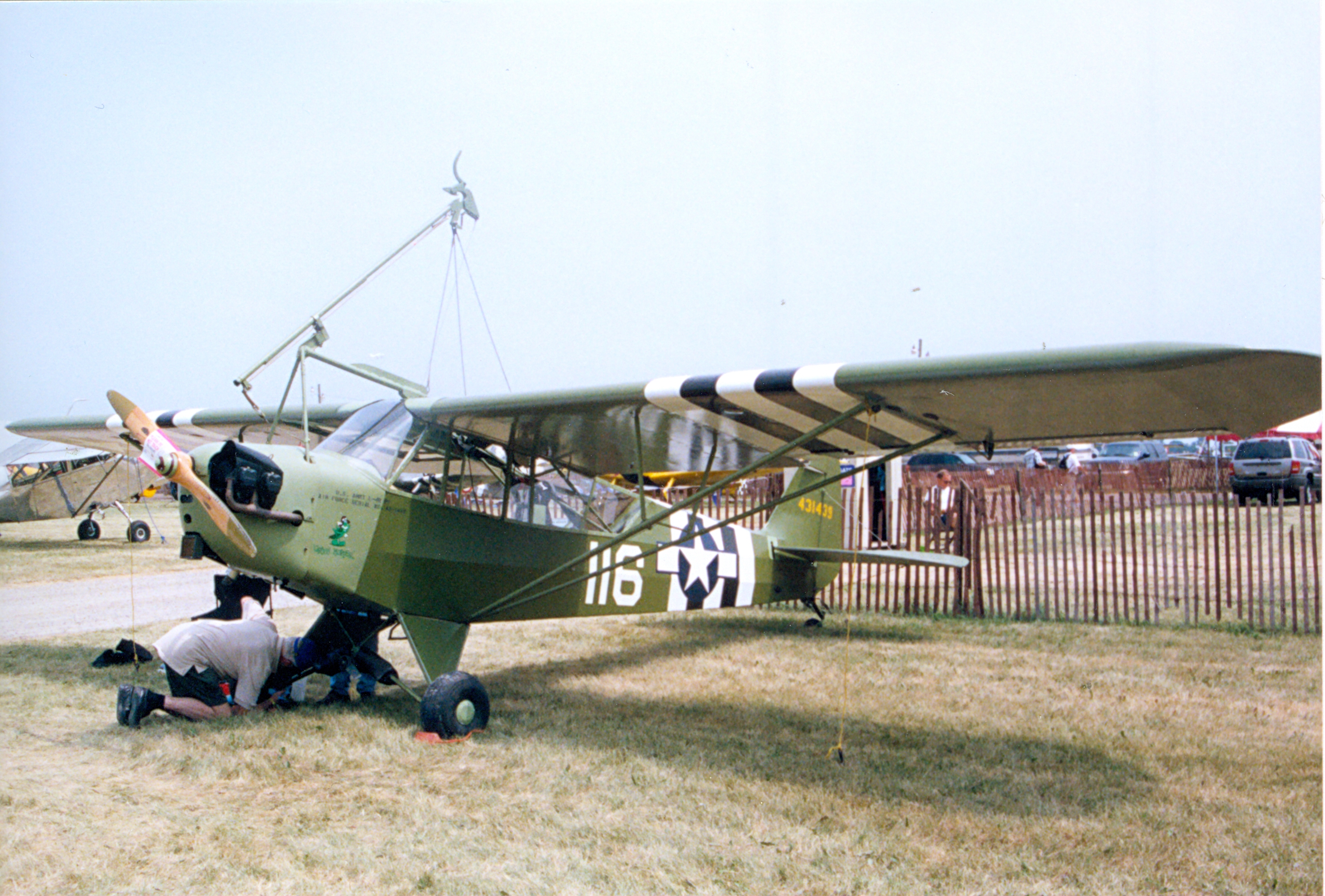Brodie Landing System on:
[Wikipedia]
[Google]
[Amazon]
 The Brodie landing system was a unique method of launching and landing light
The Brodie landing system was a unique method of launching and landing light
Brodie
''Aerofiles - A Runway on a Rope'', Accessed 2 September 2005
"L-5 Used in Pacific With Brodie System
''YouTube''
Brodie System in use for both takeoff and recovery with Piper L-4 and Stinson L-5 aircraft
''YouTube'' Types of take-off and landing Naval aviation technology {{Aviation-stub
 The Brodie landing system was a unique method of launching and landing light
The Brodie landing system was a unique method of launching and landing light aircraft
An aircraft is a vehicle that is able to fly by gaining support from the air. It counters the force of gravity by using either static lift or by using the dynamic lift of an airfoil, or in a few cases the downward thrust from jet engines ...
that was devised by Captain James H. Brodie, a member of the United States Army Air Forces
The United States Army Air Forces (USAAF or AAF) was the major land-based aerial warfare service component of the United States Army and ''de facto'' aerial warfare service branch of the United States during and immediately after World War II ...
during World War II
World War II or the Second World War, often abbreviated as WWII or WW2, was a world war that lasted from 1939 to 1945. It involved the vast majority of the world's countries—including all of the great powers—forming two opposin ...
. The novel system involved catching an overhead hook attached to the plane with a sling, which itself was attached to a cable secured between towers and acted as an arresting gear. This system was designed for launching and recovering small, lightweight liaison aircraft in terrain normally unsuitable for runway construction, such as dense jungle or in the mountains,. However, it was never tested and proved useful in those environments due to its late adoption in the war. One of its perceived advantages was that its small size would render it much harder to detect by the enemy than a conventional landing strip.
After successful demonstrations on scrub-covered flat land, the system was tested in September 1943 for shipboard use when it was installed on the motor ship . Staff Sergeant R. A. Gregory performed ten successful takeoffs and hookups without incident with a Stinson L-5
The Stinson L-5 Sentinel is a World War II-era liaison aircraft used by the United States Army Air Forces, U.S. Army Ground Forces, U.S. Marine Corps and the British Royal Air Force. It was produced by the Stinson Division of the Vultee Aircr ...
Sentinel, but those operations were conducted under ideal weather and sea conditions.
The system was adopted by the Navy and later used for launching liaison aircraft at Okinawa, Saipan, and Iwo Jima from ships called LST's. The device allowed existing vessels to be quickly converted to light aircraft carriers with few structural changes. Even though it was employed at sea with moderate success (several aircraft were lost), the pitching and rolling of the ship due to wave action made the device better suited for fixed installations on land. The Navy program was not expanded and CVE escort aircraft carriers were allocated for use during the planned invasion of Japan.
Brodie and test pilot
A test pilot is an aircraft pilot with additional training to fly and evaluate experimental, newly produced and modified aircraft with specific maneuvers, known as flight test techniques.Stinton, Darrol. ''Flying Qualities and Flight Testing ...
Flight Officer Raymond Gregory were awarded the Legion of Merit
The Legion of Merit (LOM) is a military award of the United States Armed Forces that is given for exceptionally meritorious conduct in the performance of outstanding services and achievements. The decoration is issued to members of the eight ...
for their work on the system in 1945. Brodie envisioned scaling the system up to capture planes as heavy as 7000 lbs. He was issued US Patent # 2,435,197, # 2,488,050, # 2,488,051, # 3,163,380 for variations of the landing system.
Operational history
* LST 776, LST 393, and LST 325 were outfitted with Brodie landing systems. *The RAF used an L-5 for testing the Brodie system in India. *One type of light aircraft which used the system was the Stinson L-5 Sentinel, an example of which is displayed in Brodie configuration at the Steven F. Udvar-Hazy Center museum in Dulles, Virginia.See also
*Merchant aircraft carrier
A merchant aircraft carrier (also known as a MAC ship, the Admiralty's official 'short name') was a limited-purpose aircraft carrier operated under British and Dutch civilian registry during World War II. MAC ships were adapted by adding a flig ...
* Fighter catapult armed auxiliary ship
Fighter catapult ships also known as Catapult Armed Ships were an attempt by the Royal Navy to provide air cover at sea. Five ships were acquired and commissioned as Naval vessels early in the Second World War, and these were used to accompany conv ...
* CAM ship
* Aviation-capable naval vessel
Many present-day naval vessels, aside from aircraft carriers and full-length deck amphibious assault ships, are capable of carrying aircraft. A majority of United States Navy ships have at least a helipad, capable of landing medium-sized h ...
* Aircraft catapult
References
Bibliography
*Brodie
''Aerofiles - A Runway on a Rope'', Accessed 2 September 2005
External links
"L-5 Used in Pacific With Brodie System
''YouTube''
Brodie System in use for both takeoff and recovery with Piper L-4 and Stinson L-5 aircraft
''YouTube'' Types of take-off and landing Naval aviation technology {{Aviation-stub